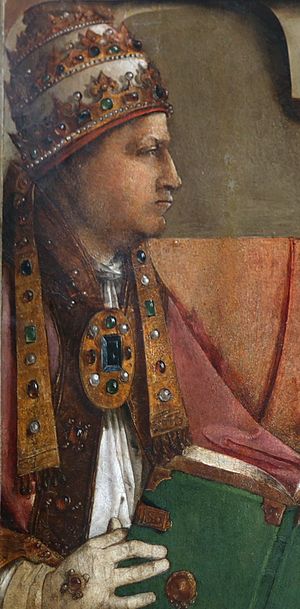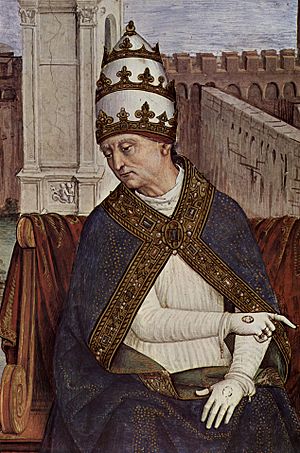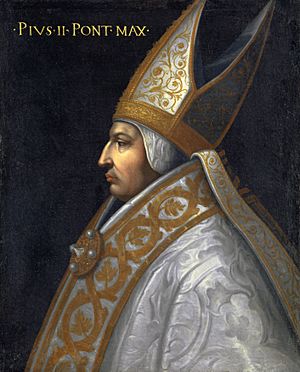Pope Pius II facts for kids
Quick facts for kids Pope Pius II |
|
|---|---|
| Bishop of Rome | |

Detail of the Portrait of Pius II by van Gent and Berruguete (c. 1472-76, Ducal Palace, Urbino)
|
|
| Church | Catholic Church |
| Papacy began | 19 August 1458 |
| Papacy ended | 14 August 1464 |
| Predecessor | Callixtus III |
| Successor | Paul II |
| Orders | |
| Ordination | 4 March 1447 |
| Consecration | 15 August 1447 by Juan Carvajal |
| Created Cardinal | 17 December 1456 |
| Personal details | |
| Birth name | Enea Silvio Bartolomeo Piccolomini |
| Born | 18 October 1405 Corsignano, Republic of Siena |
| Died | 14 August 1464 (aged 58) Ancona, Marche, Papal States |
| Other Popes named Pius | |
Pope Pius II, born Enea Silvio Bartolomeo Piccolomini (18 October 1405 – 14 August 1464), was the leader of the Catholic Church. He was also the ruler of the Papal States from August 19, 1458, until his death in August 1464. He was born in Corsignano, a town in the Sienese area. His family was noble but had become quite poor.
Pius II was a key figure in the Renaissance humanist movement. He was famous as a writer in Latin even before he became pope. His most important work is Commentaries, which tells the story of his own life. This book is special because it's the only autobiography ever written by a pope while he was still leading the Church. It was finally published in 1584.
Contents
Early Life and Studies
Enea was born to Silvio, a soldier from the House of Piccolomini, and Vittoria Forteguerri. They had 18 children. Enea worked with his father on their land for some years. When he was 18, he left home to study at the universities of Siena and Florence.
He later became a teacher in Siena. In 1431, he took a job as a secretary for Domenico Capranica, who was the bishop of Fermo. Capranica was traveling to the Council of Basel (1431–39) to protest against Pope Eugene IV. Enea joined him on this journey. After a difficult trip across the Alps, Enea worked for Capranica and then for other leaders at the Council.
Travels and Diplomacy
In 1435, Cardinal Albergati sent Enea on a secret mission to Scotland. He also visited England. He faced many dangers and challenges during these travels. His journey to Scotland was so stormy that he promised to walk barefoot to the nearest shrine of the Virgin Mary. This shrine was at Whitekirk, about 10 miles from where they landed in Dunbar. The walk through ice and snow caused him leg pain for the rest of his life. He felt much better when he reached Newcastle, calling it a "civilised part of the world."
When he returned to Basel, Enea supported the Council in its disagreements with the Pope. He even supported the creation of an Antipope Felix V (Amadeus, Duke of Savoy). Enea briefly served as Felix's secretary. In 1442, he was sent as a representative to the Diet of Frankfurt. From there, he went to the court of Holy Roman Emperor Frederick III in Vienna. The Emperor made him an imperial poet and offered him a job at court.
Changing Sides and Becoming Bishop
Enea's views had been quite flexible. In 1445, he was sent on a mission to Rome. He was forgiven for his past actions against the Pope and agreed to help Pope Eugene IV. He successfully helped to resolve differences between the Pope and the German leaders. He played a key role in a compromise in 1447. This agreement led to the Council and the antipope losing their support.
Enea had already become a priest. One of the first things Pope Nicholas V (1447–1455) did was to make him Bishop of Trieste. He later became Bishop of Siena.
In 1450, Emperor Frederick III sent Enea as an ambassador to arrange his marriage to Princess Eleonore of Portugal. In 1451, he went to Bohemia and made a good agreement with the Hussite leader George of Poděbrady. In 1452, he joined Frederick in Rome, where Frederick married Eleanor and was crowned emperor by the Pope. In 1455, Enea returned to Rome to show Germany's loyalty to the new pope, Calixtus III. He was recommended for a cardinal position, but it took time. He finally became a cardinal in December 1456.
Becoming Pope Pius II

Pope Calixtus III died on August 6, 1458. On August 10, the cardinals met to choose the next pope in a papal conclave. Enea believed he was the best choice for the job. He thought he could adapt well to the role of Pope. After some discussions among the cardinals, he received enough votes to be elected unanimously. He was crowned Pope on September 3, 1458, and took the name Pius II.
Many expected Pope Pius II to bring a new, more open era to the Vatican. He had reformed his own life and became known for his strong interest in organizing a Crusade and for insisting that the idea of Church Councils being more powerful than the Pope was wrong.
Key Actions as Pope
Pius II first formed an alliance with Ferdinand, who wanted to be king of Naples. His next important step was to call a meeting of Christian leaders in Mantua. The goal was to plan a united action against the Ottoman Turks. On September 26, 1459, he called for a new crusade. On January 14, 1460, he officially announced the crusade, which was planned to last for three years.
Life in Siena and Challenges
After the meeting, Pius II spent a lot of time in his home region of Siena. He enjoyed country life and wrote about its beauty. He also wrote about his dog, Musetta. These personal writings were later removed from the first published edition of his Commentaries because they were thought to be too informal for a pope.
He was called back to Rome because of unrest caused by Tiburzio di Maso, who was eventually caught and executed. The Papal States faced problems from rebellious nobles and wandering soldiers. Pius II slowly brought them under control. The war for the Kingdom of Naples ended with his ally Ferdinand winning. Pius II also spent much of his time fighting against Sigismondo Pandolfo Malatesta, the Lord of Rimini, eventually bringing him under control.
Pius II also tried to help end the Thirteen Years' War between Poland and the Teutonic Knights. When he couldn't find a solution, he criticized both sides. He also had disputes with King George of Bohemia and Archduke Sigismund of Austria.
Important Decisions and Building Projects
In July 1461, Pius II declared Catherine of Siena a saint. In October of the same year, he had a big success when he convinced the new king of France, Louis XI, to get rid of the Pragmatic Sanction of Bourges. This rule had greatly limited the Pope's power in France. However, Louis XI expected Pius II to support France in Naples. When this didn't happen, Louis XI brought back similar rules.
Pius II built a fortress in Tivoli called Rocca Pia in 1461. In September 1462, he approved the creation of the Diocese of Ljubljana.
Efforts for a Crusade
The crusade planned at the Mantua meeting didn't make much progress. In November 1463, Pope Pius II tried again to organize a crusade against the Ottomans. He invited all Christian nobles to join. The Venetians quickly agreed. George Kastriot Skanderbeg, the leader of Albanian resistance, also declared war on the Ottomans. Pius II's plan was to gather 20,000 soldiers in Taranto and another 20,000 with Skanderbeg. They would meet in Durazzo under Skanderbeg's command to form the main front against the Ottomans.
The Pope did his best. He even wrote a letter to the Ottoman ruler, Mehmet II, asking him to become a Christian. It's not clear if this letter was ever sent, but if it was, it didn't work. A public ceremony was held in Rome to welcome the relics of Saint Andrew's head, which were brought from the East.
Pius II also managed to help the Emperor and the King of Hungary become friends again. He also gained money from the discovery of alum mines in the papal lands at Tolfa. However, France became distant, and other European leaders did not keep their promises to help with the crusade. Knowing he was nearing his end, Pius II, despite being ill, left for Ancona on June 18, 1464, to lead the crusade himself.
Slavery and Papal Stance
In 1462, Pope Pius II spoke out against the enslavement of newly baptized Christians. He called it a "great crime" in a message to the ruler of the Canary Islands. He told bishops to punish those who did this. However, he did not condemn the idea of trading slaves in general, only the enslavement of those who had just become Christians. Later, Pope Urban VIII confirmed that Pius II's warnings were about new converts being enslaved.
Illness and Death
Even though he had a fever, Pope Pius II left Rome for Ancona. He hoped to boost the spirits of the crusading army. However, the army began to disappear in Ancona because there were no ships to transport them. When the Venetian fleet finally arrived, the dying Pope could only see it from a window. He passed away two days later, on August 14, 1464. Pope Paul II became the next pope.
Pius II's body was first buried in Old St. Peter's Basilica in the Vatican. Later, his body and parts of his tomb were moved to the church of Sant'Andrea della Valle in 1612.
Legacy and Writings
Pius II was one of the most important writers of his time. His most famous and longest work is his autobiography, Commentaries. It has 12 or 13 books and was first published in 1584. His distant relative, Archbishop Francesco Bandini Piccolomini, published it. He made some changes, removing parts that might have seemed unflattering. He published it under the name of a scribe, Iohannes Gobellinus, which led to a misunderstanding that Gobellinus was the author. However, Pius II wrote it from a third-person point of view, similar to how Caesar wrote.
Pius II was also admired as a poet. His reputation in literature mostly comes from his story The Tale of Two Lovers. He also wrote some comedies, and one of them, called Chrysis, still exists today. All of these works are in Latin.
His Epistles (letters), which he collected himself, are also a valuable source of historical information. His histories of Bohemia and of Emperor Frederick III are among his most important shorter historical writings. He also wrote about Europe and Asia, and in his earlier life, he wrote many essays on political, religious, and ethical topics. He even wrote a detailed argument against Islam.
His Epistles include a well-known description of the enthronement ceremony of the Carinthian dukes. This description is thought to be the source for Jean Bodin's account of the ceremony in his book Six Livres de la République.
Pius II was not a top scholar. He wrote Latin very well, but he knew little Greek.
Pope Pius II started a unique city planning project. He rebuilt his hometown of Corsignano in Tuscany and renamed it Pienza, after himself. A beautiful cathedral and palaces were built there, and they can still be seen today. He also issued a papal bull, Cum almam nostram urbem, which made it illegal to damage ancient ruins in Rome or Campagna. In 1551, his collected works were first published in Basel.
See also
 In Spanish: Pío II para niños
In Spanish: Pío II para niños
- Cardinals created by Pius II
- Gregory of Heimburg, secretary to Pius II
- Pope Pius III, nephew of Pius II
- Bishops of Warmia
- Pienza


